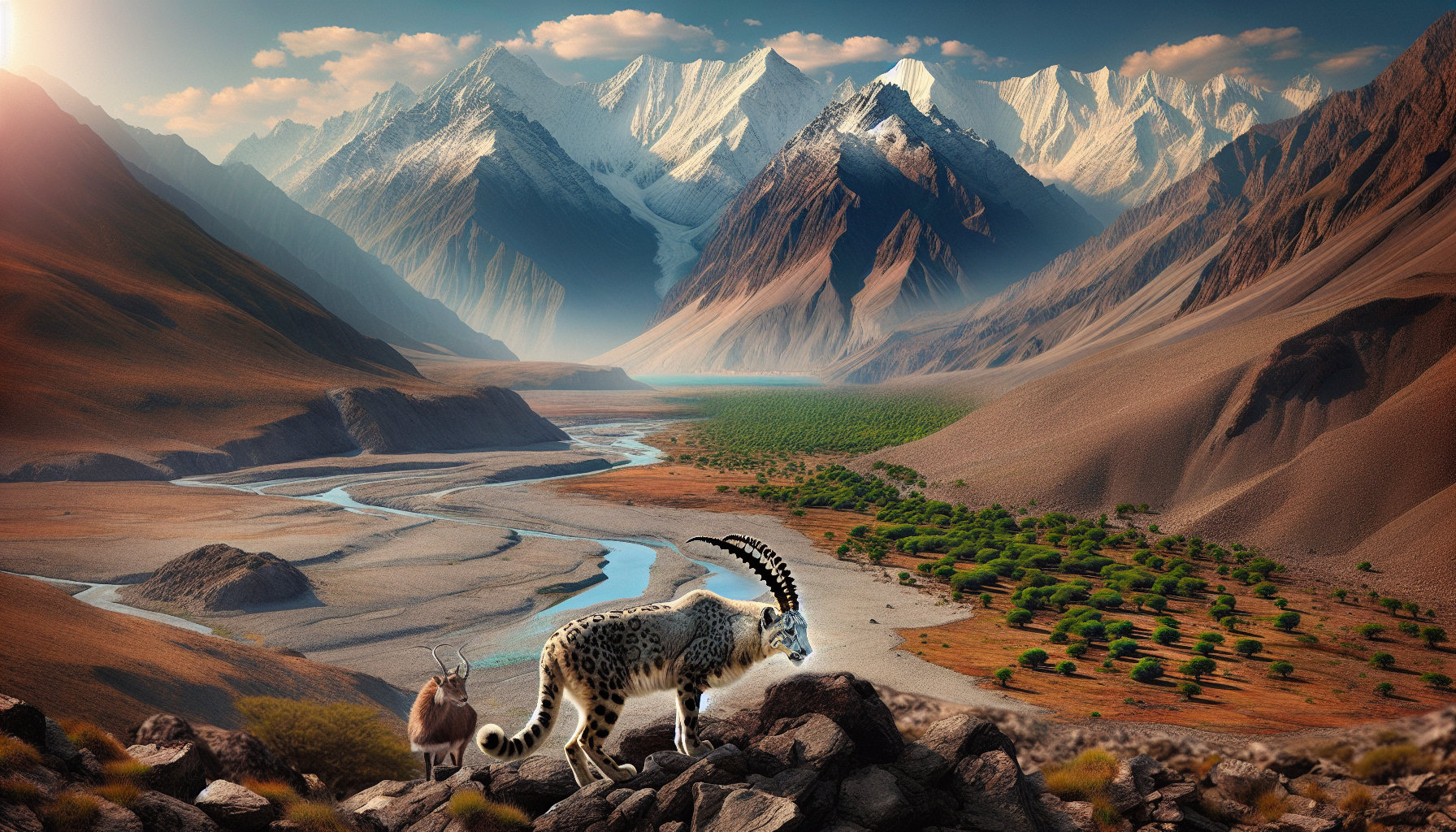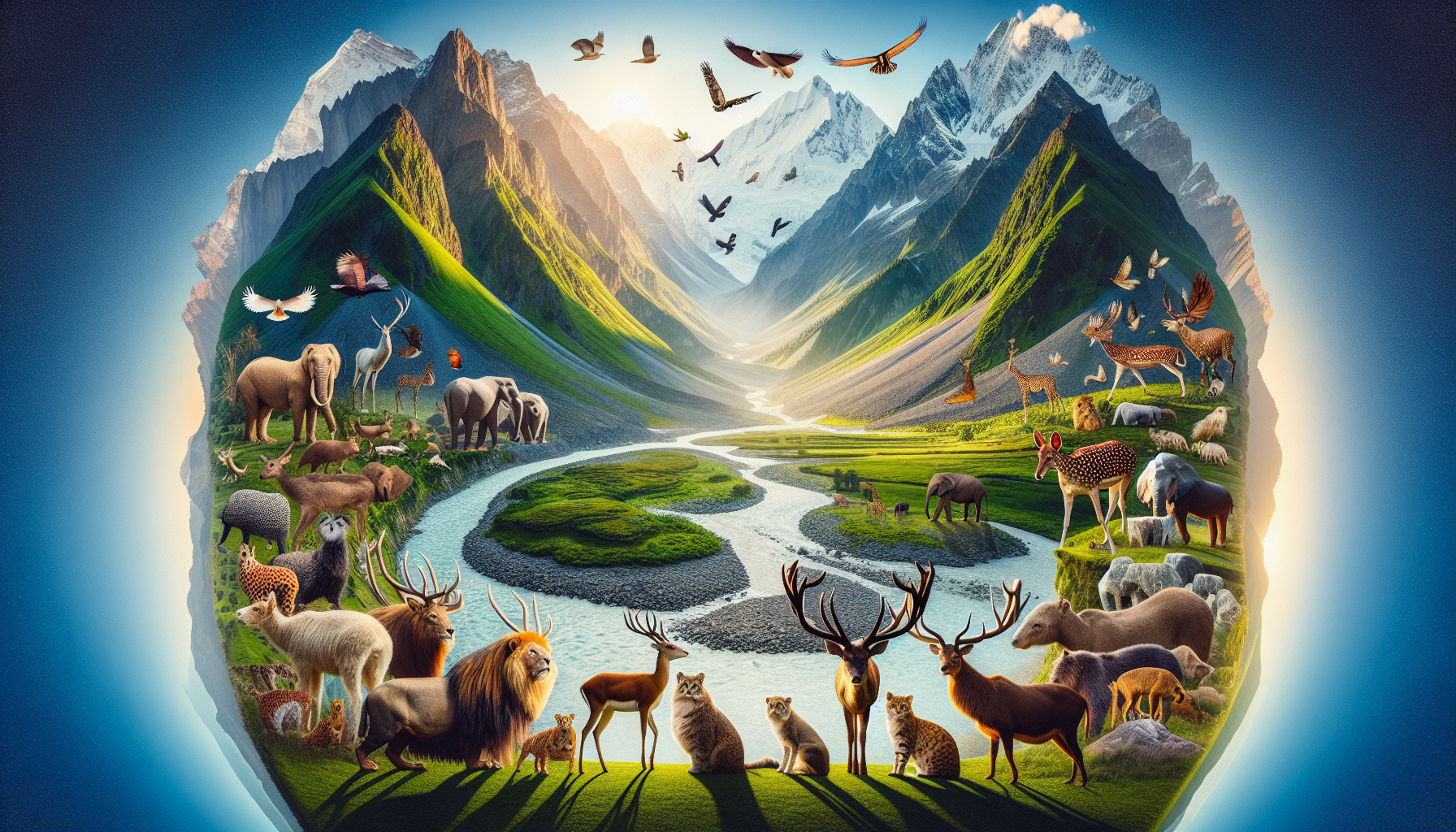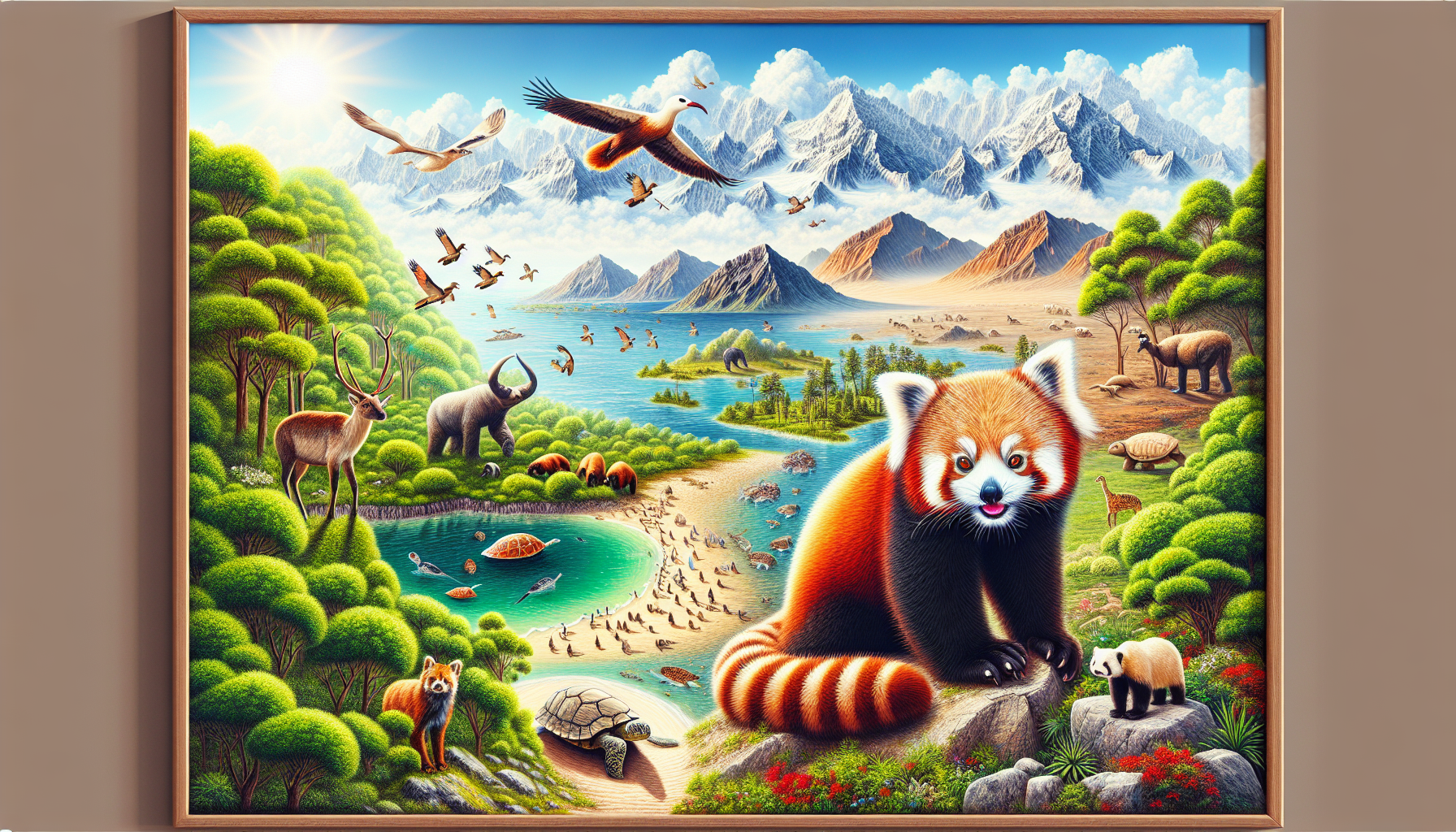Pakistan is a treasure trove for photographers seeking the best wildlife photography locations in Pakistan: Discover Natural Wonders. From the snow-capped peaks of the Himalayas to the lush forests of the north, each region offers unique opportunities. I still remember my first visit to the majestic Deosai National Park. The park is home to the rare Himalayan brown bear, and capturing their playful antics in the wild was an unforgettable experience. For bird enthusiasts, the serene waters of Haleji Lake, which attract thousands of migratory birds each year, are a must-visit. Don’t forget to pack your zoom lens to capture these exquisite creatures up close. Make sure to check seasonal migrations at World Wildlife Fund for the best times to visit.
Related: The Ultimate Guide to Wildlife Photography in Pakistan: Master Nature's Beauty
Capturing the Natural Wonders of Pakistan's National Parks
Exploring the national parks of Pakistan offers photographers a chance to capture nature’s breathtaking beauty. Whether you’re a seasoned professional or an enthusiastic amateur, the diversity of landscapes and wildlife here is unparalleled. I’ve spent countless weekends traversing these parks, each visit revealing new wonders.
Discovering Hidden Gems in the Wilderness
One of my favorite spots is the majestic Hingol National Park. Located in Balochistan, it’s a treasure trove of unique landscapes and rare species. The park’s rugged terrain and the striking Hingol River create perfect backdrops for wildlife photography. Keep an eye out for the elusive Sindh Ibex and the majestic Arabian Oryx. These animals, with their graceful movements, make for stunning subjects.
Another must-visit is the enchanting Deosai National Park in Gilgit-Baltistan. Known as the “Land of Giants,” this park is a paradise for those seeking to photograph the elusive Himalayan brown bear. You’ll find endless fields of wildflowers in the summer, adding vibrant colors to your shots. Deosai is also one of the few places where you can find the Golden Marmot, a charming creature that often poses for the camera.
Tips for a Successful Photography Trip
To make the most of your visit, consider these tips:
- Visit during early morning or late afternoon for the best lighting.
- Bring a telephoto lens to capture distant wildlife.
- Be patient and respect the natural habitat of the animals.
For those passionate about wildlife photography, Pakistan’s national parks offer an incredible opportunity to discover natural wonders. Each visit not only enhances your portfolio but also deepens your appreciation for the country’s rich biodiversity. For more on animal behavior and photography techniques, check out resources like National Geographic and World Wildlife Fund.
Best Time to Visit Pakistan for Wildlife Photography

Pakistan is a treasure trove of breathtaking landscapes and diverse wildlife, making it a paradise for photographers. To capture the most stunning shots, timing is everything. The best period for wildlife photography in Pakistan is between October and March. During these months, the weather is cooler and more pleasant, which is ideal for both photographers and the animals they capture.
Optimal Seasons for Capturing Nature’s Beauty
Spring and autumn are particularly spectacular. In spring, blossoming flowers and lush greenery enhance the natural beauty of locations like the Deosai National Park. Autumn brings vibrant hues to the forests, especially in the northern regions like Swat and Hunza Valley. These times offer not just great weather but also a chance to witness migratory birds in full flight.
Unique Wildlife Experiences
During the winter months, from December to February, the snow leopards of the Himalayas become more visible. This is an incredible opportunity for those looking to photograph one of the world’s most elusive animals. Seeing a snow leopard in its natural habitat is a surreal experience that few photographers forget. According to a report by The Guardian, the conservation efforts have been crucial in maintaining their population.
I’ve personally found early mornings to be the best time for shooting. The soft light of dawn creates a magical atmosphere, and the wildlife tends to be more active. Remember to carry a good pair of binoculars and a telephoto lens. These are essential tools for capturing the hidden gems of Pakistan’s diverse ecosystems.
Essential Gear for Wildlife Photography in Pakistan
Embarking on a wildlife photography adventure in Pakistan is an exhilarating experience that demands the right equipment. Having explored the lush landscapes and diverse fauna of Pakistan, I can share some personal insights into the essential gear you’ll need. During my trips to the breathtaking expanses of the Deosai National Park and the rugged terrain of Hingol, I’ve learned that preparation is key.
Must-Have Photography Equipment
Your camera is your most important tool. For capturing the vibrant wildlife, I recommend a DSLR or mirrorless camera with a fast shutter speed and high burst rate. A 200mm or 300mm telephoto lens is crucial for those hard-to-reach subjects like the elusive snow leopard or the majestic Himalayan bear. Trust me; the right lens can make a world of difference in your photographs.
Additionally, a sturdy tripod is invaluable. It helps stabilize your camera for those low-light shots at dawn or dusk. In places like the wetlands of the Indus River, where lighting can be unpredictable, a tripod is a lifesaver. Don’t forget extra batteries and memory cards. The last thing you want is to run out of power or storage in the middle of nowhere.
Field Essentials and Safety Gear
Beyond camera equipment, consider the environment. Pakistan’s diverse landscape means weather conditions can change rapidly. I always pack weatherproof clothing and sturdy boots. A good backpack that can hold your gear comfortably is also essential. It ensures ease of movement and protects your equipment from the elements.
For those new to wildlife photography, I recommend checking out The Ultimate Guide to Wildlife Photography in Pakistan: Capture Rare Species & Scenic Landscapes. It offers invaluable tips and advice tailored for Pakistan’s unique settings.
Finally, always prioritize your safety and the safety of the wildlife. Carry a first-aid kit and familiarize yourself with the local wildlife regulations. The thrill of capturing a rare moment is unparalleled, but it should never come at the cost of your or the animal’s well-being. For more information on wildlife safety, you might want to look into guidelines provided by WWF Pakistan or IUCN Red List.
Tips for Photographing Rare Species in Pakistan
When photographing rare species in Pakistan, patience is your best friend. I’ve spent countless hours in the wetlands of Sindh, waiting for the elusive Indus River dolphin to surface. It teaches you the art of waiting and observing.
Exploring Natural Wonders: Where to Begin
Start your journey in the northern regions. The breathtaking scenery of the Deosai National Park offers a stunning backdrop and is home to the Himalayan brown bear. Early mornings are ideal for capturing these majestic creatures. The light is softer and the animals are more active.
In the wetlands of Punjab, you’ll find the endangered Bengal florican. This region is particularly challenging due to its vast landscapes. Use a telephoto lens to capture detailed shots from a distance. When I first encountered these birds, their vibrant plumage against the lush green was unforgettable.
Preparation is Key
Always research the species you’re targeting. Understanding their behavior and habitats increases your chances of success. I recommend carrying a field guide or using reliable online resources like the IUCN Red List to learn about local wildlife.
- Dress appropriately for the terrain. Camouflage clothing helps you blend into the environment without startling the animals.
- Carry a tripod for stability, especially in low-light conditions.
- Stay quiet and minimize movement to avoid disturbing the wildlife.
Remember, the goal is to capture these creatures in their natural habitat. Respect the environment and maintain a safe distance. Your photographs will be more meaningful when they reflect authentic and ethical interactions with wildlife.
Best Wildlife Photography Locations in Pakistan: Discover Natural Wonders

Pakistan is a land of breathtaking landscapes and diverse wildlife. It’s a paradise for photographers looking to capture the country’s natural beauty. Over the years, I’ve had the pleasure of exploring several stunning locations that offer amazing opportunities for wildlife photography. Here are some personal favorites that I highly recommend.
Explore the Rich Biodiversity of the Margalla Hills
The Margalla Hills National Park, located near Islamabad, is a treasure trove of flora and fauna. It’s an excellent spot for capturing images of unique bird species like the Himalayan griffon vulture and the Indian paradise flycatcher. On my last visit, I managed to photograph a magnificent pair of white-cheeked bulbul. The trails here are easily accessible, making it a perfect day trip for both amateur and professional photographers.
Capture the Majesty of the Deosai Plains
The vast Deosai National Park is another must-visit location for wildlife enthusiasts. Known as the ‘Land of Giants’, this park is home to the Himalayan brown bear, a rare species that offers a remarkable subject for your lens. It was here that I captured the most awe-inspiring shots of the bears roaming freely against the stunning backdrop of rolling meadows and snow-capped peaks. The experience is nothing short of magical.
When planning your trips, consider the best seasons for wildlife activity. Early spring and late autumn are particularly rewarding times. If you’re keen to learn more about the unique ecosystems in these areas, check out resources like the World Wildlife Fund or Wildlife Conservation Society. They offer valuable insights into the conservation efforts and biodiversity of Pakistan’s natural wonders.
Conclusion
As we wrap up our journey through the natural wonders of Pakistan, it’s clear that our country offers a treasure trove of breathtaking wildlife photography locations. From the majestic peaks of the Karakoram Range to the serene wetlands of Sindh, each region has its unique charm and rare species waiting to be captured through your lens.
Discovering the Hidden Gems
One of my favorite spots is the Hingol National Park. Nestled in Balochistan, this park features spectacular landscapes and diverse fauna. I remember my first visit there, spotting a family of ibex gracefully navigating the rugged cliffs. It was a moment that made me appreciate the untouched beauty of our land. If you’re planning a trip, don’t forget your long lens; the wildlife can be elusive yet rewarding to photograph.
In Punjab, the Cholistan Desert offers a different kind of beauty. The annual Jeep Rally is thrilling, but the desert’s true allure lies in its quiet sunsets and the chance to see the rare houbara bustard. Make sure to time your visit with the migratory season for the best shots.
Travel Tips for Wildlife Enthusiasts
- Always check the weather forecast before heading out.
- Respect the natural habitat by keeping a safe distance from wildlife.
- Bring a versatile camera kit to adapt to different lighting and terrain conditions.
For those who seek adventure, Pakistan is a paradise for wildlife photographers. Its diverse ecosystems offer endless opportunities to capture the extraordinary. Always be prepared to stumble upon something unexpected. Whether you’re a local or a traveler, the experiences you gain will be invaluable. For more on wildlife photography tips, explore resources like the National Geographic or WWF Pakistan.
Continue Exploring
Unlock the secrets to breathtaking wildlife photography! Dive into the art of making your photos pop with expert tips on stunning post-processing techniques for 2025 and discover the ultimate gear guide for capturing wildlife in its most vibrant form. Ready to elevate your photography game? Let’s get started!
Frequently Asked Questions
What are the top wildlife photography spots in Pakistan for capturing rare species?
Pakistan is home to diverse ecosystems, offering incredible opportunities for wildlife photography. Some of the top spots include the Khunjerab National Park for snow leopards, the Hingol National Park for unique rock formations and diverse wildlife, and the Deosai National Park for Himalayan brown bears. These locations provide stunning backdrops and rare species for photographers seeking unique shots.
When is the best time to visit Pakistan for wildlife photography?
The best time to visit Pakistan for wildlife photography depends on the region and species you wish to capture. Generally, spring (March to May) and autumn (September to November) are ideal for most regions due to moderate weather and active wildlife. For snow leopards, winter months are preferable, while summer is best for visiting high-altitude national parks like Deosai.
What equipment should I bring for a successful wildlife photography trip in Pakistan?
For a successful wildlife photography trip in Pakistan, it’s essential to bring a quality DSLR or mirrorless camera, a telephoto lens for capturing distant wildlife, and a wide-angle lens for scenic landscapes. A sturdy tripod, extra batteries, memory cards, and weather-resistant gear are also recommended. Don’t forget to pack appropriate clothing for varying weather conditions, especially in mountainous areas.


Leave a Reply